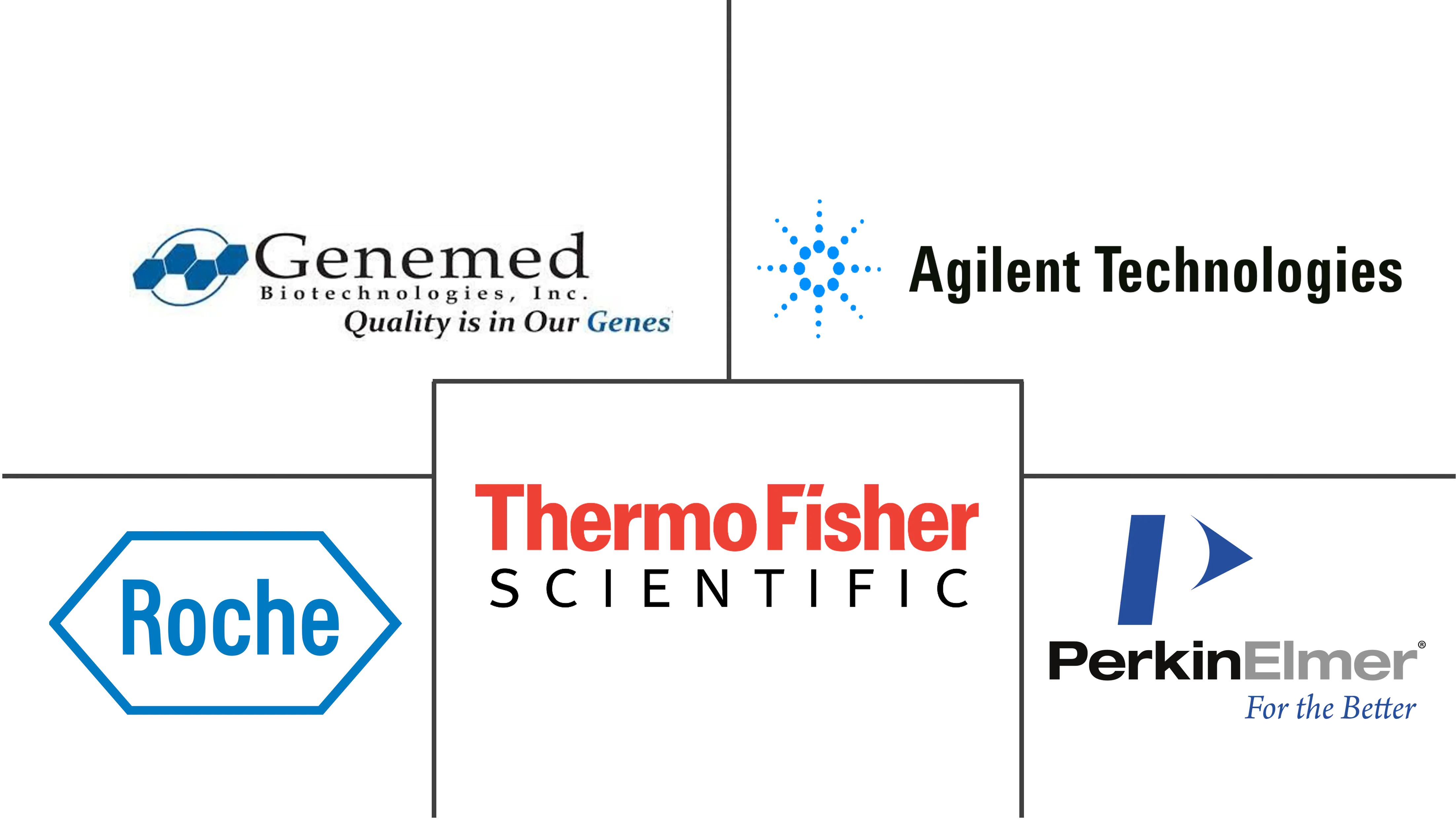Fluorescent In Situ Hybridization Market Size and Share
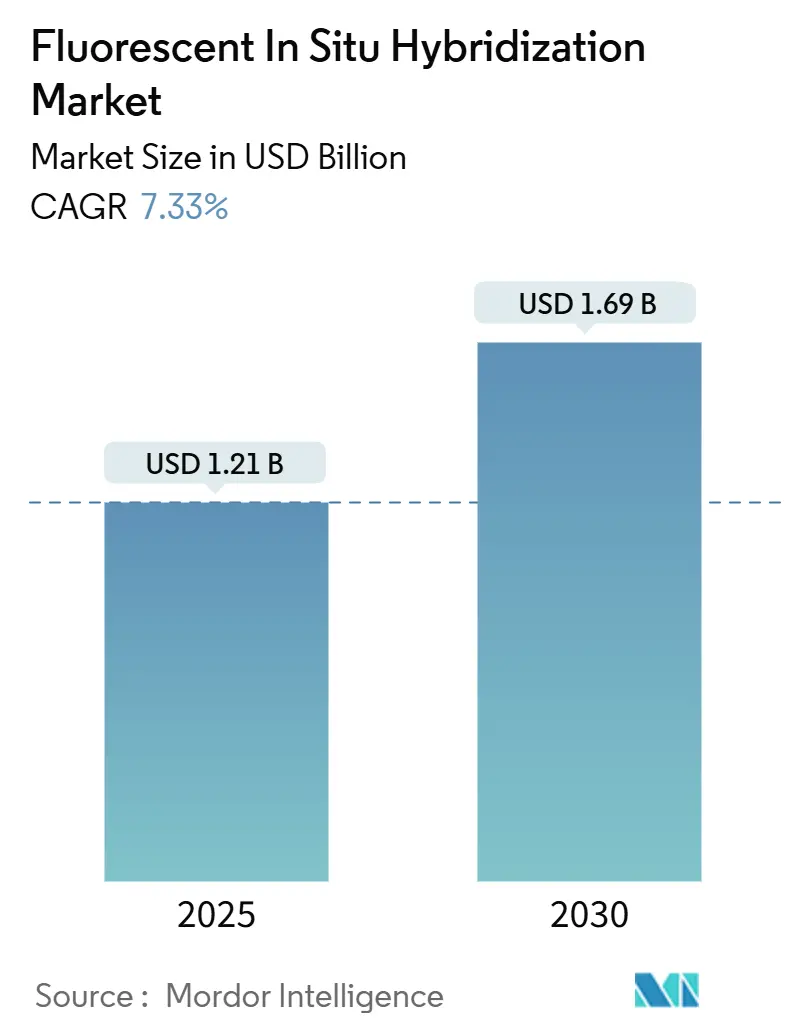
Fluorescent In Situ Hybridization Market Analysis by Mordor Intelligence
The Fluorescent In Situ Hybridization Market size is estimated at USD 1.21 billion in 2025, and is expected to reach USD 1.69 billion by 2030, at a CAGR of 7.33% during the forecast period (2025-2030).
This advance reflects rising cancer incidence, broader reimbursement for genomic tests, and the transition from manual cytogenetics to AI-enabled digital pathology. Demand is reinforced by pharmaceutical reliance on FISH assays for companion diagnostics, lower probe manufacturing costs, and expanding single-cell applications that validate cell and gene-therapy products. Suppliers leverage integrated imaging systems that shorten turnaround times while mitigating laboratory staffing gaps, and payers view FISH as cost-effective when it prevents ineffective therapy selections. Regional momentum remains strongest in Asia-Pacific where precision-medicine programs, local probe production, and portable readers accelerate access.
Key Report Takeaways
- By product type, kits and reagents held 44.37% of fluorescent in situ hybridization market share in 2024, while digital imaging and analysis systems are projected to grow at 9.44% CAGR through 2030.
- By application, cancer diagnostics accounted for 62.34% share of the fluorescent in situ hybridization market size in 2024; cell and gene-therapy quality control is expected to expand at 10.52% CAGR to 2030.
- By end user, clinical diagnostic laboratories led with 47.42% revenue share in 2024, whereas pharmaceutical and biotech companies are set to grow at 11.08% CAGR through 2030.
- By geography, North America dominated with 43.04% revenue share in 2024; Asia-Pacific is forecast to register the fastest 9.96% CAGR between 2025 and 2030.
Global Fluorescent In Situ Hybridization Market Trends and Insights
Drivers Impact Analysis
| Driver | (~) % Impact on CAGR Forecast | Geographic Relevance | Impact Timeline |
|---|---|---|---|
| Rising Global Cancer Incidence & Wider Genomic Testing Reimbursement | +1.8% | Global, with strongest impact in North America & Europe | Medium term (2-4 years) |
| Escalating Adoption of FISH in Companion Diagnostics for Targeted Oncology Drugs | +1.5% | Global, led by North America, expanding to APAC | Short term (≤ 2 years) |
| Rapid Fall in Probe Manufacturing Costs Due to Ink-Jet Oligo Synthesis | +1.2% | Global manufacturing hubs, particularly Asia-Pacific | Long term (≥ 4 years) |
| Expansion of Digital Pathology Platforms Integrating AI-Augmented FISH Image Analytics | +1.4% | North America & Europe initially, scaling to APAC | Medium term (2-4 years) |
| Growing Demand for Single-Cell Cytogenomics in Cell & Gene-Therapy Process QC | +0.9% | North America & Europe, emerging in Asia-Pacific | Long term (≥ 4 years) |
| Commercialization of Portable, Battery-Powered FISH Readers for Low-Resource Settings | +0.5% | APAC, MEA, Latin America | Long term (≥ 4 years) |
| Source: Mordor Intelligence | |||
Rising Global Cancer Incidence & Wider Genomic Testing Reimbursement
Cancer-related FISH volumes grow as payers approve broader genomic panels for breast, lung, and hematologic malignancies. The FDA endorsement of Roche’s PATHWAY HER2 test for biliary-tract cancer in 2024 showed how regulatory recognition enlarges patient pools beyond traditional settings.[1]Roche Communications, “FDA Approves PATHWAY HER2 Test for Biliary Tract Cancer,” roche.com Insurers view precision diagnostics as a cost saver when matched therapies avoid ineffective regimens. Laboratories pair FISH with next-generation sequencing to heighten diagnostic accuracy and still secure reimbursement. This virtuous cycle supports steady uptake across hospital and reference labs in North America and Europe.
Escalating Adoption of FISH in Companion Diagnostics for Targeted Oncology Drugs
Pharmaceutical pipelines depend on chromosomal translocation and gene-amplification assays to qualify trial cohorts. The FDA approval of zanidatamab for HER2-positive biliary-tract cancer, backed by a FISH-based companion diagnostic, underscored FISH’s role in unlocking niche oncology markets.[2]OncLive Editorial Staff, “FDA Authorizes Zanidatamab Companion Diagnostic,” onclive.com Co-development models align drug and assay timelines, lowering clinical risk for both parties. High assay specificity limits false positives, protecting therapeutic effect claims. As trial sponsors build in-house cytogenetics groups to shorten study cycles, the fluorescent in situ hybridization market gains a durable revenue stream.
Rapid Fall in Probe Manufacturing Costs Due to Ink-Jet Oligo Synthesis
Industrial ink-jet systems now deliver 99.5% coupling efficiencies with costs down to USD 0.002 per base, enabling affordable high-quality probes in emerging laboratory environments. Localized production in China and India trims import tariffs and shipping delays, fueling Asia-Pacific’s 9.96% CAGR. Academic groups have demonstrated 3D-printed synthesizers that further depress unit costs, expanding access to customized probes for rare cytogenetic targets. These structural savings widen the fluorescent in situ hybridization market by lowering entry barriers for mid-size hospitals and research institutes.
Expansion of Digital Pathology Platforms Integrating AI-Augmented FISH Image Analytics
AI-enabled algorithms raise mitosis-detection accuracy in breast carcinoma from 62% to 76% and cut interpretation time by 40%.[3]MDPI Diagnostics Collective, “AI-Assisted Mitotic Count Improves Breast Pathology,” mdpi.com European guidelines now promote fully digital workflows with standardized quality checkpoints. Integration through HL7 interfaces lets FISH image outputs stream directly into electronic medical records, producing faster clinician reports. Vendors that bundle scanners, image analysis, and LIS connectivity, therefore, capture premium positions in the fluorescent in situ hybridization market.
Restraints Impact Analysis
| Restraint | (~) % Impact on CAGR Forecast | Geographic Relevance | Impact Timeline |
|---|---|---|---|
| Shortage of Cytogenetic Technologists in Developed Economies | -0.8% | North America & Europe primarily | Short term (≤ 2 years) |
| High Capital Outlay for Fully Automated FISH Workstations | -0.6% | Global, most acute in emerging markets | Medium term (2-4 years) |
| Reproducibility Challenges in Multiplex RNA-FISH Probes | -0.4% | Global research and clinical applications | Long term (≥ 4 years) |
| Stringent Validation Hurdles for Laboratory-Developed FISH Tests Under IVDR (EU) | -0.7% | European Union, with spillover effects globally | Medium term (2-4 years) |
| Source: Mordor Intelligence | |||
Shortage of Cytogenetic Technologists in Developed Economies
Vacancy rates in US cytogenetics labs reached 13.2% in 2024 and nearly 27% of current technologists expect to retire within five years. Automation eases slide preparation and scoring, yet final case sign-off still demands certified staff. Laboratories therefore face overtime costs and delayed turnaround, which can blunt the fluorescent in situ hybridization market’s near-term growth in North America and Europe. Vendor training programs and remote-expert networks offer partial relief, but credential pipelines remain stretched.
High Capital Outlay for Fully Automated FISH Workstations
Integrated staining, hybridization, and imaging platforms cost USD 350,000-400,000, a hurdle for mid-tier hospitals in Latin America and Southeast Asia. Leasing models and reagent-rental contracts can soften the blow, yet budget cycles in public health systems slow adoption. Portable readers ease point-of-care testing but cannot yet handle high-volume oncology screens. This pricing tension constrains the fluorescent in situ hybridization industry until scale economies lower system costs.
Segment Analysis
By Product Type: Digital Systems Drive Innovation
The segment opened 2024 with kits and reagents supplying 44.37% revenue, emphasizing the consumable foundation of the fluorescent in situ hybridization market. DNA probes dominate routine HER2 and ALK testing, while RNA probes gain traction in spatial transcriptomics. Instruments account for roughly one-third of sales, split between manual microscopes for low-volume labs and high-throughput automated stations. Software and services form the balance, expanding as cloud-based analytics gain regulatory acceptance.
Digital imaging systems, buoyed by AI algorithms, are the fastest risers at 9.44% CAGR. Median HER2 signal count rose from 4.0 to 7.5 per nucleus on a super-resolution platform, proving diagnostic uplift. Automation reduces chemical exposure and turnaround times, winning favor with overstretched laboratory staff. Vendors that align consumables with scanners through closed-loop ecosystems deepen customer lock-in and stabilize the fluorescent in situ hybridization market size at the product level. Digital platforms also open remote-read opportunities that lighten the technologist's burden. Cloud architectures transfer image data across sites without quality loss, while AI triages high-risk slides for senior review. This workflow lets regional hospitals access subspecialty expertise without geographic constraints, broadening the fluorescent in situ hybridization market reach in rural settings. As probe and imaging suppliers co-develop turnkey bundles, pricing moves toward outcome-based models tied to report volumes, aligning vendor and laboratory incentives.
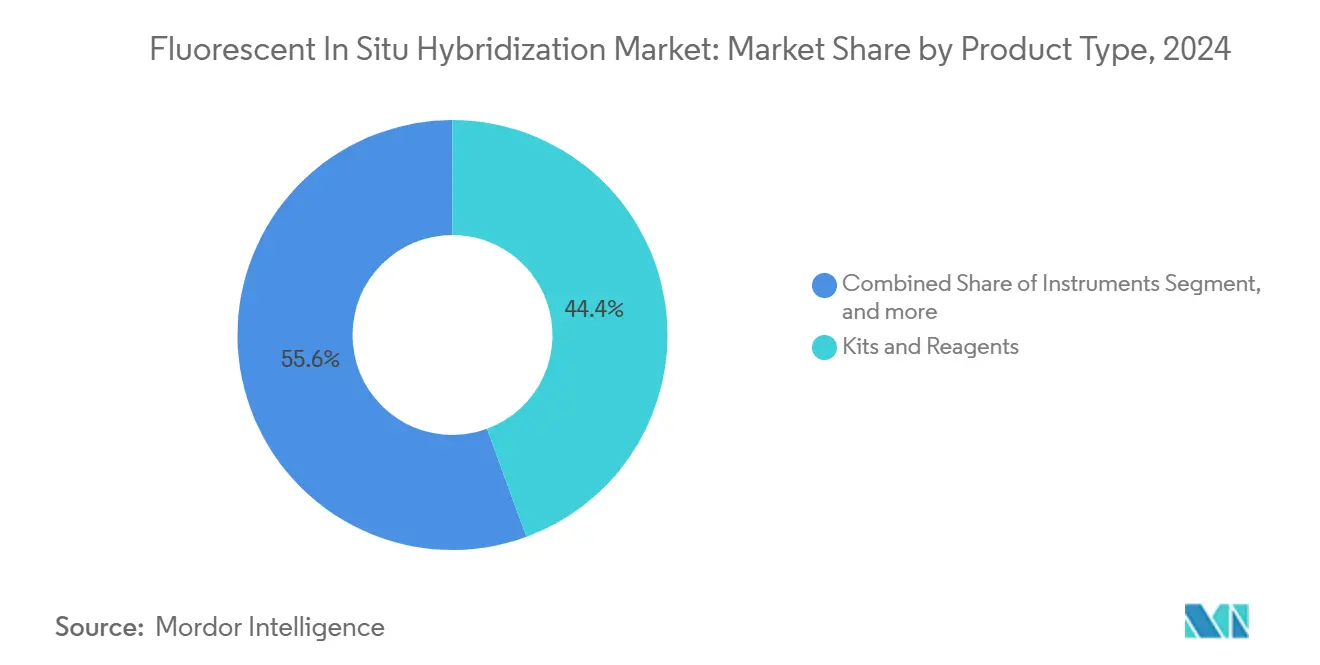
Note: Segment shares of all individual segments available upon report purchase
By Application: Cell Therapy QC Accelerates Growth
Cancer diagnostics remained the anchor at 62.34% fluorescent in situ hybridization market share in 2024, spanning breast, lung, and hematologic assays. Breast cancer testing benefits from mature reimbursement and clear ASCO-CAP guidelines, while lung-fusion testing competes with next-generation sequencing but retains value in rapid intraoperative settings. Prenatal and constitutional genetic screens deliver steady volumes, though their growth lags oncology. The fluorescent in situ hybridization market size for cell and gene-therapy quality control is growing as regulators tighten genomic-stability demands. Gene-edited CAR-T processes incorporate multi-color FISH panels to detect vector integration hotspots before lot release. Single-cell approaches map clonal diversity, safeguarding efficacy and safety.
As living medicines mature, lot-release testing windows compress, forcing labs to automate hybridization and scoring. Vendors now supply GMP-grade probe kits with certificate of analysis for regulatory filings. Partnerships between therapy developers and diagnostics firms shorten validation timelines, aligning assay deployment with phase 3 study milestones. This synergy draws new capital into the fluorescent in situ hybridization industry and speeds global standardization of best-practice QC protocols.
By End User: Pharma Companies Lead Growth
Clinical diagnostics laboratories furnished 47.42% of 2024 revenue, underpinned by routine oncology testing managed through centralized models. Hospital cytogenetics units commanded about a quarter of volumes, focusing on complex karyotype interpretation. Academic centers and contract research organizations together supplied niche research and overflow capacity. Pharmaceutical and biotech firms, however, are poised for the fastest 11.08% CAGR as they internalize FISH for biomarker-driven trials. Agilent’s USD 925 million acquisition of BioVectra underscored the importance of in-house oligonucleotide control. Drug sponsors seek data sovereignty, faster iteration, and alignment with regulatory submission packs. Consequently, they equip process-development suites with automated imagers and validated probes, expanding the fluorescent in situ hybridization market footprint inside industry campuses.
Vendor service arms now run embedded laboratories within sponsor facilities to blend diagnostics know-how with therapeutic workflows. This model trims specimen logistics and guards intellectual property, while subscription contracts convert capital spending into operational budgets. As portfolio pipelines diversify into solid tumors and rare diseases, FISH assay menus expand, reinforcing vendor relationships and enlarging the fluorescent in situ hybridization market.
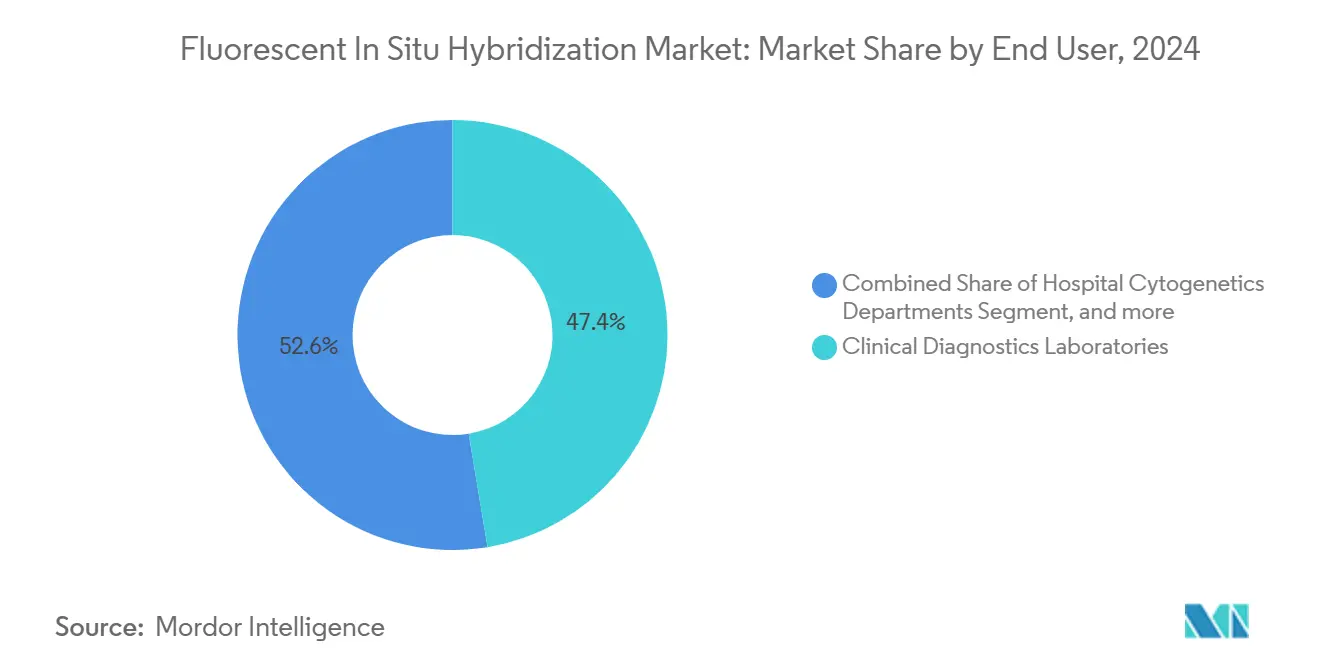
Note: Segment shares of all individual segments available upon report purchase
Geography Analysis
North America held 43.04% revenue in 2024, anchored by comprehensive insurance coverage, large cancer-center networks, and an ecosystem of reference laboratories. The United States benefits from clear FDA pathways and national proficiency-testing programs that ensure assay quality. Canada provides stable growth through universal healthcare, while Mexico’s private-hospital segment adopts portable FISH readers for oncology screening. The region also houses many AI start-ups that license algorithms into existing lab information systems, raising platform value.
Europe, led by Germany, the United Kingdom, and France, contributed to global demand. IVDR compliance raised near-term costs, yet set standard quality benchmarks that favor vendors with robust documentation. Italy’s deployment of deep learning for digital slides advanced reimbursement discussions for telepathology services. Spain and other Southern markets integrate companion diagnostics into national cancer strategies, broadening patient access. Despite currency pressures, public health digitization funds support the procurement of automated FISH systems.
Asia-Pacific is projected to record the highest 9.96% CAGR. China’s public-insurance reforms now list multiple FISH assays, driving rural uptake. India’s premier institutes pilot AI tools that shorten report times and standardize interpretation. Japan’s aging population raises screening volumes, while Australia and South Korea combine developed reimbursement models with vibrant biotech pipelines. Local probe factories lower costs and circumvent logistics delays, which sustains adoption in Southeast Asia. Portable, battery-powered readers serve field oncology programs in Indonesia and Vietnam, expanding the fluorescent in situ hybridization market reach.

Competitive Landscape
The fluorescent in situ hybridization market exhibits moderate consolidation. A small set of global suppliers integrates probe manufacture, instrumentation, and analytic software, enabling bundled solutions that command premium pricing. Abbott maintains one of the largest commercially available probe libraries with more than 300 Vysis assays, covering common and rare oncogenic targets. Roche, Agilent, and Thermo Fisher invest in AI acquisitions to accelerate digital-pathology rollouts. Vertical integration secures component quality and simplifies regulatory filings, particularly important under IVDR.
Strategic collaborations with pharmaceutical firms for companion-diagnostic co-development remain a core theme. Such partnerships align assay validation with drug-registration timelines and guarantee initial testing volumes once therapies reach market. Market entrants focus on differentiated niches. Companies developing multiplex FISH for spatial transcriptomics address research clients requiring thousands of gene targets. Others build portable systems for decentralized cancer programs in low-resource settings. Acquisition activity centers on filling portfolio gaps in automation, cloud analytics, and GMP probe production.
Regulatory scrutiny shapes competitive dynamics. Vendors certified to ISO 13485 and compliant with EU IVDR gain fast-track acceptance in hospital tenders. Smaller firms face steep documentation costs, encouraging licensing deals with larger players. Workforce shortages propel demand for turnkey automated lines that minimize operator steps. This environment sustains R&D spending on robotics, AI, and novel fluorophores, reinforcing competitive barriers around intellectual property and service networks.
Fluorescent In Situ Hybridization Industry Leaders
-
Agilent Technologies
-
Genemed Technologies Inc.
-
Thermo Fisher Scientific Inc.
-
PerkinElmer
-
F. Hoffmann-La Roche Ltd.
- *Disclaimer: Major Players sorted in no particular order
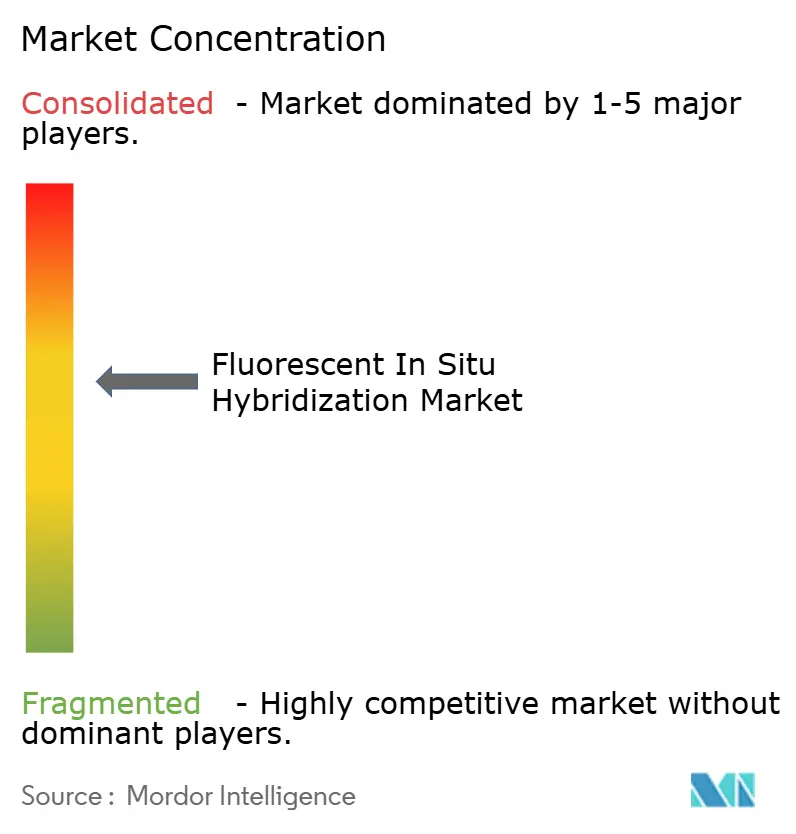


Recent Industry Developments
- January 2025: bioMérieux acquired SpinChip Diagnostics ASA for EUR 111 (USD 130) million, enhancing point-of-care diagnostics capabilities with rapid immunoassay platform delivering lab-quality results from whole blood samples in 10 minutes, targeting high-sensitivity cardiac markers with CE marking under IVDR expected by end of 2025.
- January 2025: FDA approved Roche's PATHWAY HER2 (4B5) test as first HER2-ultralow companion diagnostic for metastatic breast cancer, expanding treatment eligibility for trastuzumab deruxtecan and demonstrating strong concordance with HER2 FISH assays.
- November 2024: Roche received FDA approval for PATHWAY HER2 (4B5) test as first companion diagnostic identifying HER2-positive biliary tract cancer patients eligible for ZIIHERA treatment, addressing lack of standardized HER2 testing for this indication.
- July 2024: Agilent Technologies announced acquisition of BioVectra for USD 925 million, enhancing capabilities in gene editing and oligonucleotide production to position as comprehensive provider of gene editing technologies including guide RNAs for CRISPR-Cas9 applications.
Global Fluorescent In Situ Hybridization Market Report Scope
As per the scope of the report, Fluorescent In Situ Hybridization (FISH) is mainly used for diagnostic purposes and involves fluorescent probes that bind to a nucleic acid that very well complements it. The Fluorescent In Situ Hybridization Market is segmented by Product Type (Analytical Instrument, Kits & Reagents, and Software & Services), Application (Cancer, Genetic Diseases, and Others), and Geography (North America, Europe, Asia-Pacific, Middle East and Africa, and South America). The market report also covers the estimated market sizes and trends for 17 different countries across major regions globally. The report offers the value (in USD million) for the above segments.
| Instruments | Automated FISH Workstations |
| Manual Fluorescence Microscopes | |
| Digital Imaging & Analysis Systems | |
| Kits & Reagents | DNA Probes |
| RNA Probes | |
| PNA / LNA Probes | |
| Software & Services |
| Cancer Diagnostics | Breast Cancer |
| Lung Cancer | |
| Hematologic Malignancies | |
| Genetic Disease Screening | |
| Neurological Disorders | |
| Companion Diagnostics | |
| Cell & Gene-Therapy Manufacturing QC | |
| Others |
| Clinical Diagnostics Laboratories |
| Hospital Cytogenetics Departments |
| Academic & Research Institutes |
| Pharma & Biotech Companies |
| Contract Research Organizations |
| North America | United States |
| Canada | |
| Mexico | |
| Europe | Germany |
| United Kingdom | |
| France | |
| Italy | |
| Spain | |
| Rest of Europe | |
| Asia-Pacific | China |
| Japan | |
| India | |
| Australia | |
| South Korea | |
| Rest of Asia-Pacific | |
| Middle East & Africa | GCC |
| South Africa | |
| Rest of Middle East & Africa | |
| South America | Brazil |
| Argentina | |
| Rest of South America |
| By Product Type | Instruments | Automated FISH Workstations |
| Manual Fluorescence Microscopes | ||
| Digital Imaging & Analysis Systems | ||
| Kits & Reagents | DNA Probes | |
| RNA Probes | ||
| PNA / LNA Probes | ||
| Software & Services | ||
| By Application | Cancer Diagnostics | Breast Cancer |
| Lung Cancer | ||
| Hematologic Malignancies | ||
| Genetic Disease Screening | ||
| Neurological Disorders | ||
| Companion Diagnostics | ||
| Cell & Gene-Therapy Manufacturing QC | ||
| Others | ||
| By End User | Clinical Diagnostics Laboratories | |
| Hospital Cytogenetics Departments | ||
| Academic & Research Institutes | ||
| Pharma & Biotech Companies | ||
| Contract Research Organizations | ||
| By Geography | North America | United States |
| Canada | ||
| Mexico | ||
| Europe | Germany | |
| United Kingdom | ||
| France | ||
| Italy | ||
| Spain | ||
| Rest of Europe | ||
| Asia-Pacific | China | |
| Japan | ||
| India | ||
| Australia | ||
| South Korea | ||
| Rest of Asia-Pacific | ||
| Middle East & Africa | GCC | |
| South Africa | ||
| Rest of Middle East & Africa | ||
| South America | Brazil | |
| Argentina | ||
| Rest of South America | ||


Key Questions Answered in the Report
What is the current size of the fluorescent in situ hybridization market?
The market stands at USD 1.21 billion in 2025 and is set to reach USD 1.69 billion by 2030, posting a 7.33% CAGR.
Which product category commands the largest share of the fluorescent in situ hybridization market?
Kits and reagents lead with 44.37% market share, reflecting constant consumable demand from diagnostic laboratories.
Why is Asia-Pacific the fastest growing region?
Healthcare-infrastructure investments, local probe manufacturing, and national precision-medicine initiatives drive a 9.96% CAGR across China, India, and Japan.
How are AI tools influencing the fluorescent in situ hybridization industry?
AI-augmented image analysis boosts diagnostic accuracy, lowers interpretation time, and supports automated workflows that help labs manage staffing shortages.
What factors are fueling demand for FISH assays in cell and gene-therapy manufacturing?
Regulators require rigorous genomic-stability testing before lot release, and multi-color FISH panels detect chromosomal aberrations in engineered cells, driving a 10.52% CAGR for this application.
Which end-user segment is growing fastest?
Pharmaceutical and biotech companies lead with an 11.08% CAGR as they integrate FISH into companion-diagnostic development and cell-therapy quality control.
Page last updated on:
